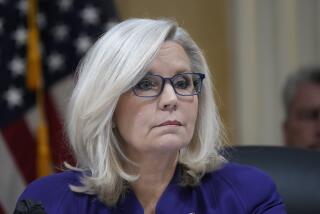Cheney held briefings on interrogation
- Share via
WASHINGTON — Former Vice President Dick Cheney personally oversaw at least four briefings with senior members of Congress about controversial interrogation programs, part of a secretive and forceful defense he mounted throughout 2005 in an effort to maintain support for the harsh techniques used against detainees.
The Cheney-led briefings came at some of the most crucial moments for the program, as congressional oversight committees were threatening to investigate or even terminate the techniques used in interrogations, according to lawmakers, congressional officials and current and former intelligence officials.
Cheney’s role in helping handle intelligence issues in the Bush administration has been well documented, particularly his advocacy for the use of aggressive methods and warrantless wiretapping against suspected terrorists. But his hands-on role in defending the interrogation program to lawmakers has not been previously publicized.
The CIA made no mention of the former vice president’s role in documents delivered to Capitol Hill last month which listed every lawmaker who had been briefed on “enhanced interrogation techniques” since 2002. For meetings that were overseen by Cheney, the agency told the intelligence committees that information about who oversaw those briefings was “not available.”
The revelations do not shed light on whether top Democrats, as Republicans contend, were aware that waterboarding, a harsh technique that simulates drowning, was being employed on suspected terrorists as early as the fall of 2002. That discussion has dominated Capitol Hill since last month, when House Speaker Nancy Pelosi, who was not present at any of the briefings that included Cheney, accused the agency of misleading her in a 2002 briefing about the use of waterboarding.
An official who witnessed one of Cheney’s briefing sessions with lawmakers said the vice president’s presence appeared calculated to give additional heft to the CIA’s case for maintaining the program. Cheney left it to the professional briefers to outline the interrogation practices, while he mounted an impassioned defense of the program.
“This is a really important issue for the security of the United States,” the official recalled Cheney saying.
The CIA declined to comment on why Cheney’s presence in meetings was left out of the records. One senior intelligence official, speaking on the condition of anonymity, said identities of individual briefers are intentionally concealed in all cases -- names do not appear in any of the CIA documents that describe congressional briefings. In at least some cases, he added, the identity of the briefer was never recorded in the agency’s internal records. For all but seven of the 40 meetings listed, however, the documents outlined which agency led the briefing and which provided support.
One of the most critical Cheney-led briefings came in late October 2005 when the vice president and Porter Goss, then director of the CIA, described the interrogation methods to Sen. John McCain (R-Ariz.), according to congressional and intelligence sources.
One knowledgeable official described the meeting as contentious. Cheney and Goss, with other CIA officials present, tried to persuade the former Vietnam POW to back off an anti-torture amendment that had already won the backing of 90 senators as part of the annual spending bill for the Defense Department.
The McCain amendment would have ended practices such as waterboarding by forbidding “cruel, degrading and inhumane” treatment of detainees. The CIA had not used waterboarding since 2003, but the White House sought to maintain the ability to employ it in future interrogations.
Earlier, Cheney met with a friendlier audience, Sens. Thad Cochran (R-Miss.) and Ted Stevens (R-Alaska), who oversaw the Pentagon’s appropriation measure and were longtime Cheney friends. Cochran said Tuesday that it was the first time he had been given a full description of what waterboarding entailed.
CIA records indicate another “briefing” -- for whom the briefer is “not available” -- was given to Senate GOP leaders on Nov. 1, 2005. That was the same day Cheney made his regular appearance at the weekly Tuesday luncheon for Senate Republicans.
After staffers were cleared from the room, Cheney discussed the value of the interrogation program and the information gleaned from the harsh techniques, according to contemporaneous media accounts.
Cheney’s briefing on interrogations began in the winter of 2005 as the top Democrats on the Senate and House intelligence committees, Sen. John D. Rockefeller IV (D-W.Va.) and Rep. Jane Harman (D-Venice) publicly advocated a full investigation of the tactics used against top Al Qaeda terrorism suspects.
On March 8, 2005 -- two days after a detailed report in the New York Times about interrogations -- Cheney gathered Rockefeller, Harman and the chairmen of the intelligence panels, Sen. Pat Roberts (R-Kan.), and Rep. Peter Hoekstra (R-Mich.), according to current and former intelligence officials.
Weeks earlier, Roberts had publicly suggested possible support for the interrogation investigation sought by Rockefeller.
But by early March 2005, Roberts announced that he opposed a separate investigation, and the matter soon died.
More to Read
Sign up for Essential California
The most important California stories and recommendations in your inbox every morning.
You may occasionally receive promotional content from the Los Angeles Times.













